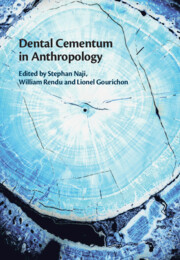Book contents
- Dental Cementum in Anthropology
- Dental Cementum in Anthropology
- Copyright page
- Dedication
- Contents
- Contributors
- Foreword
- Introduction: Cementochronology in Chronobiology
- Part I The Biology of Cementum
- Part II Protocols
- 9 Cementochronology for Archaeologists: Experiments and Testing for an Optimized Thin-Section Preparation Protocol
- 10 Optimizing Preparation Protocols and Microscopy for Cementochronology
- 11 Cementochronology Protocol for Selecting a Region of Interest in Zooarchaeology
- 12 Tooth Cementum Annulations Method for Determining Age at Death Using Modern Deciduous Human Teeth: Challenges and Lessons Learned
- 13 The Analysis of Tooth Cementum for the Histological Determination of Age and Season at Death on Teeth of US Active Duty Military Members
- 14 Preliminary Protocol to Identify Parturitions Lines in Acellular Cementum
- 15 Toward the Nondestructive Imaging of Cementum Annulations Using Synchrotron X-Ray Microtomography
- 16 Noninvasive 3D Methods for the Study of Dental Cementum
- Part III Applications
- Index
- Plate Section (PDF Only)
- References
10 - Optimizing Preparation Protocols and Microscopy for Cementochronology
from Part II - Protocols
Published online by Cambridge University Press: 20 January 2022
- Dental Cementum in Anthropology
- Dental Cementum in Anthropology
- Copyright page
- Dedication
- Contents
- Contributors
- Foreword
- Introduction: Cementochronology in Chronobiology
- Part I The Biology of Cementum
- Part II Protocols
- 9 Cementochronology for Archaeologists: Experiments and Testing for an Optimized Thin-Section Preparation Protocol
- 10 Optimizing Preparation Protocols and Microscopy for Cementochronology
- 11 Cementochronology Protocol for Selecting a Region of Interest in Zooarchaeology
- 12 Tooth Cementum Annulations Method for Determining Age at Death Using Modern Deciduous Human Teeth: Challenges and Lessons Learned
- 13 The Analysis of Tooth Cementum for the Histological Determination of Age and Season at Death on Teeth of US Active Duty Military Members
- 14 Preliminary Protocol to Identify Parturitions Lines in Acellular Cementum
- 15 Toward the Nondestructive Imaging of Cementum Annulations Using Synchrotron X-Ray Microtomography
- 16 Noninvasive 3D Methods for the Study of Dental Cementum
- Part III Applications
- Index
- Plate Section (PDF Only)
- References
Summary
Counting dental acellular cementum (AC) annulations is used to estimate age at death in anthropological contexts by embedding the tooth, sectioning the root, and imaging the thin sections. However, there are several published protocols creating confusion to optimize these steps. We compared three standard illumination techniques (differential interference contrast; transmitted bright field; transmitted polarized) on sections with the same thickness, field of view, on three types of samples: fresh teeth embedded in both MMA and epoxy; archeological samples embedded in epoxy. We compared the quality of AC increment visibility on longitudinal and transversal sections of the same root, to optimize the quality of AC micrographs for age estimation. Results suggest that differential interference contrast microscopy might be ideal, even though brightfield consistently provides a decent image; epoxy resin with quick polymerization time doesn't affect AC structure and allows for higher contrast than traditional MMA; transverse sections are more consistent. These results emphasize the need for cementum-specific procedures not always compatible with traditional dental analyses.
- Type
- Chapter
- Information
- Dental Cementum in Anthropology , pp. 189 - 200Publisher: Cambridge University PressPrint publication year: 2022



